Table of Contents
Introduction
As the first drops of rain kiss the parched earth, Karnataka transforms into a lush, emerald wonderland. The monsoon season, stretching from June to September, breathes new life into the state’s forests, rivers, waterfalls, and hill stations. While many shy away from travel during the rains, true explorers know this is when Karnataka is at its most breathtaking.
From the misty hills of Coorg and Chikmagalur to the roaring Jog Falls, the monsoon cloaks the landscape in mist and magic. Trekking trails are lined with wildflowers, waterfalls cascade in full force, and the aroma of wet earth and coffee fills the air. Whether you’re a nature lover, adventure seeker, or a couple in search of a romantic escape, Karnataka offers a monsoon getaway like no other.
In this guide, we bring you the Top 10 Monsoon Destinations in Karnataka, complete with scenic routes, lush forests, hidden waterfalls, and cool mountain air – all waiting to be explored under the spell of the rains.
Famous Top 10 Monsoon Destinations in Karnataka
1. Coorg (Kodagu)
Coorg is a misty Western Ghats hill district known for lush coffee estates, verdant forests and thundering waterfalls. In Top 10 Monsoon Destinations in Karnataka its hills turn emerald green and iconic sites like Abbey Falls (a scenic cascade near Madikeri) swell dramatically with rain. The capital Madikeri’s Raja’s Seat viewpoint offers panoramic valley vistas after the rains. This coffee country is ideal for couples enjoying plantation walks and quiet homestays or solo trekkers heading for peaks.
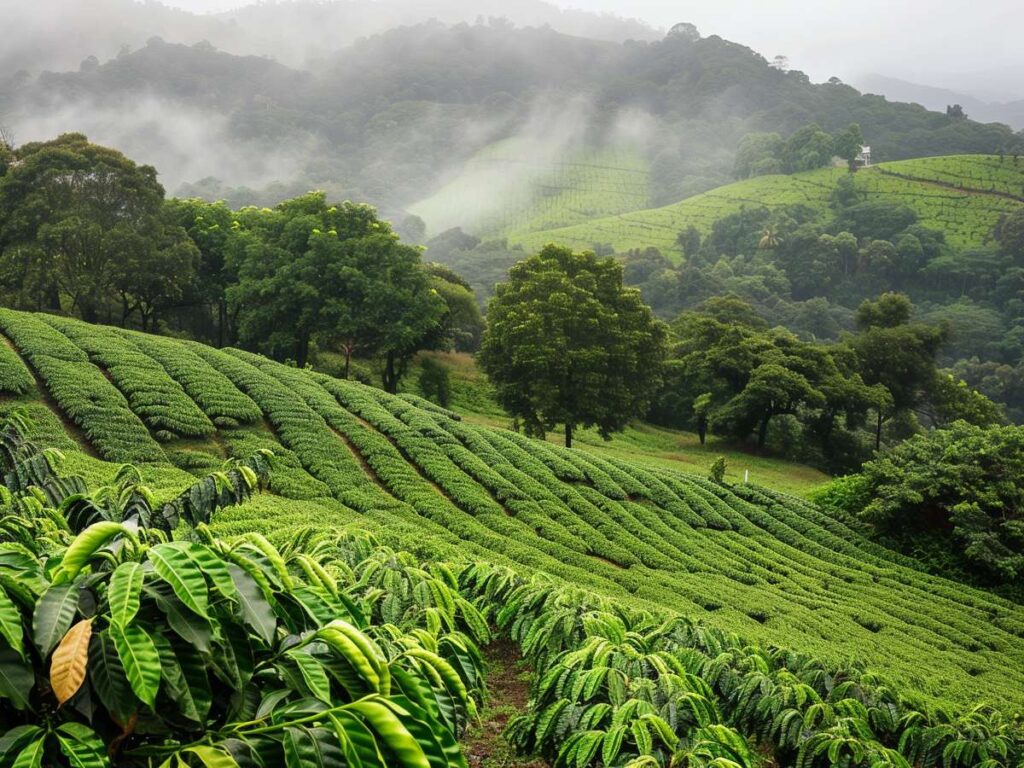
- Key attractions: Abbey Falls (full flow in rains); Raja’s Seat (sunrise/sunset viewpoint); Dubare Elephant Camp (river island with elephants); Namdroling Monastery (Tibetan Golden Temple at nearby Bylakuppe); coffee plantation tours; Tadiandamol Peak (highest Coorg trek ~1,748 m).
- Best things to do: Trek Tadiandamol or Brahmagiri (for sweeping misty views); wander through emerald coffee/pepper estates; take a coracle-boat ride or gentle rafting on the Barapole River; enjoy birdwatching (hornbills, trogons) and a nature bath under rains. Romantic activities include torch-lit walks and campfires at lodges, and mornings spent sipping Coorg’s famous filter coffee amid the mist.
- Ideal time: July to September (monsoon peaks, cooler weather). The rains begin in June and crest by July–August, keeping waterfalls at maximum flow. Avoid the very heaviest downpours in late June/early July; mid- to late-monsoon (July–Aug) yields lush landscapes and still-accessible sights.
- Travel tips: Pack waterproof gear and sturdy boots – trails and roads become very slippery in rain. Allow extra travel time; mountain roads may have landslides or flooding (avoid night driving). Use the Mandalpatti/Dubare routes instead of less-maintained roads. Mosquito repellent and quick-dry clothing are a must. Reserve homestays or resorts in advance, as monsoon is peak season in Coorg.
2. Chikmagalur
Nestled below the Baba Budangiri hills, Chikmagalur is a coffee‑clad hill station with misty peaks. Its green valleys and Mullayanagiri Peak (Karnataka’s highest at ~1,930 m) come alive in the rains. Chikmagalur’s forests host many waterfalls (e.g. Hebbe, Kallathigiri) and ancient temples amid the coffee groves. After rains, the region is tranquil and fog‑shrouded – perfect for contemplative walks.
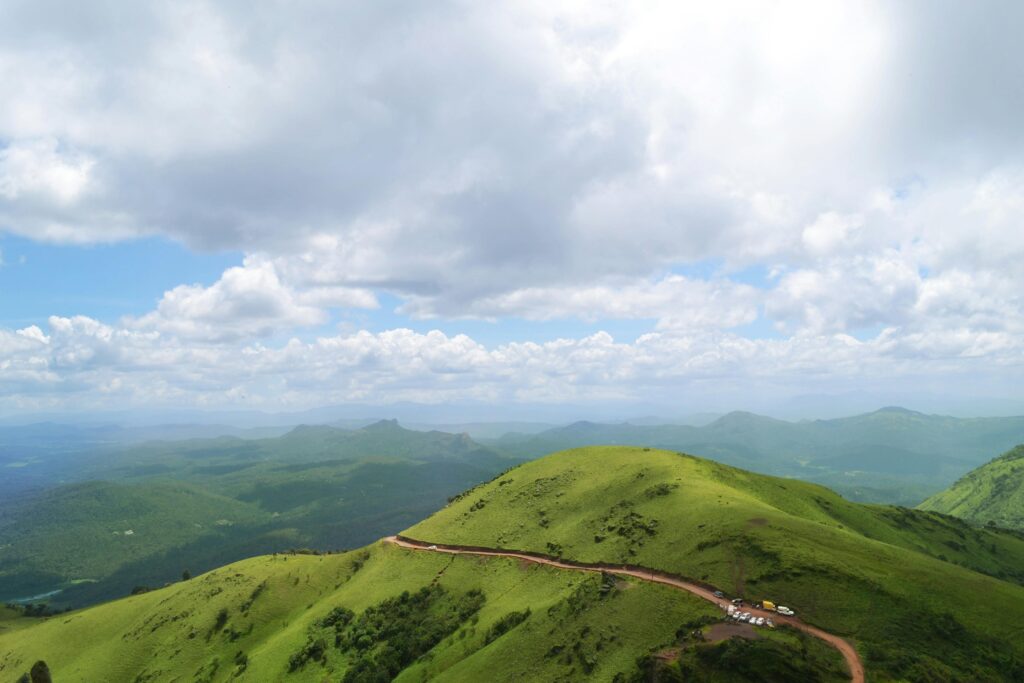
- Key attractions: Mullayanagiri and nearby Baba Budangiri hills (360° views, morning mist). Hebbe Falls (40 m cascade in dense forest); Hirekolale Lake and Shanti Seat viewpoint; historic Jain temples (e.g. Belavadi Narasimhaswamy).
- Best things to do: Trek the Baba Budangiri → Mullayanagiri trail for sunrise; jeep safari through coffee estates; walk or bike through the aromatic plantations; visit Bhadra Wildlife Sanctuary (proximity to Chikmagalur) for birdwatching; sample local Malnad cuisine (wild mushrooms, bamboo shoot curry).
- Ideal time: July–September, when heavy rains have turned hills green and waterfalls roaring. Early monsoon (July) yields the fullest streams, while late monsoon (Sept) still offers deep green forests (treks are more challenging in peak rain). Postpone high-altitude treks until rains ease slightly to avoid cloud-cover.
- Travel tips: Wear anti-leech socks for forest treks. Watch for landslides on the winding roads to Baba Budangiri. Permits may be needed for certain treks (check forest department rules). Carry warm layers for cool, foggy mornings. Local guides are advisable for remote trails.
3. Agumbe
Agumbe village in Shimoga (Chikkamagaluru district) is famed as the “Cherrapunji of the South” for receiving extremely high rainfall. It lies deep in the Western Ghats rainforests, so the entire area becomes an emerald jungle in monsoon. Agumbe’s Sunset View Point affords sweeping Ghats vistas, and nearby waterfalls like Barkana Falls (850 ft drop) are at peak fury. The region’s wild, wet character makes it a paradise for nature lovers.
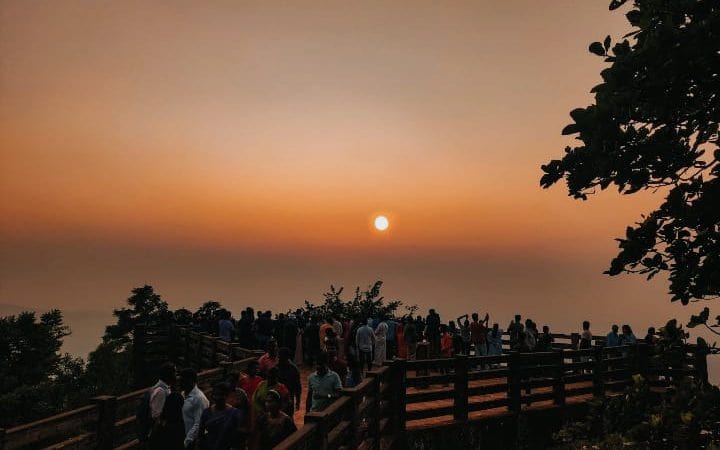
- Key attractions: Agumbe Sunset Point (viewpoint over misty valley at dusk); dense rainforests around Agumbe village; Barkana Falls and Onake Abbi Falls (scenic high waterfalls accessed by short jungle hikes); Agumbe Rainforest Research Station (herpetology center).
- Best things to do: Trek through ghat forests to nearby waterfalls (the paths are lush but slippery); spot endemic wildlife (king cobras, Malabar pit vipers, colourful frogs and butterflies) in the early morning; enjoy the cool rainforest climate and torrential showers; photography of rain-drenched ferns and canopies (especially at Barkana).
- Ideal time: July–September for fullest waterfalls and green forests. Agumbe’s monsoon typically starts in June and lasts into September. The heaviest rains occur July–August, so plan visits on sunny or lightly rainy days to enjoy views. The “rainy season” atmosphere – with mist rising off the forest – is the highlight.
- Travel tips: Roads up the Agumbe Ghat are narrow and winding; drive slowly, especially in low visibility. Trails to falls are slippery; sturdy boots and a walking stick are recommended. Follow the local advice about dangerous creatures (e.g. do not wander off-trail). Mosquito repellent and water-resistant packs are essential. Because rainfall is heavy, limit equipment to essentials and protect cameras/electronics.
4.Jog Falls (Sharavathi Falls)
Jog Falls is one of India’s tallest plunge waterfalls (≈830 ft) and a must-see monsoon spectacle. Fed by the Sharavathi River, the falls split into four segments that thunder down in August–September, creating misty rainbows. The view from the official platform (near Talakalale village) is dramatic after rains.
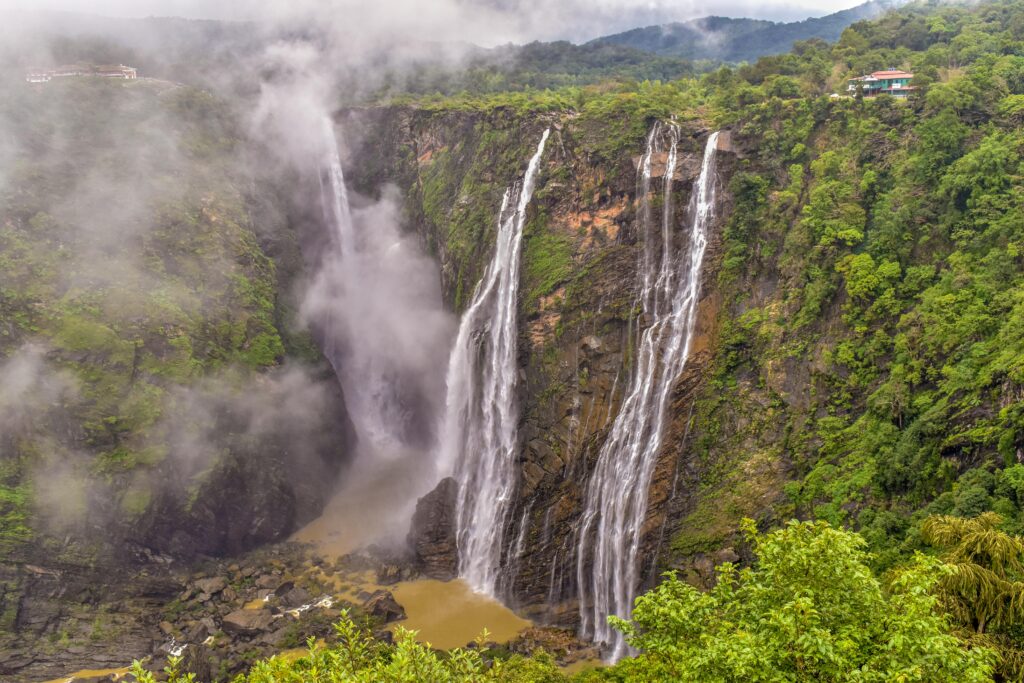
- Key attractions: The main Jog Falls viewpoint (circuit lookout by the road) when the Sharavathi is roaring; nearby smaller falls (Rani and Rocket) visible from various trails; forested trails around the site.
- Best things to do: Walk the short trail to the bottom basin for a closer view (keep distance from the slippery rocks); view the falls at sunrise/sunset (with misty light); take a local boat on the Sharavathi gorge (if offered); nearby Iruppu Falls can be a quieter alternative. The area also has a small museum on local history.
- Ideal time: August–September, when monsoon is fullest and Jog Falls is gushing. Early July to mid-August rains fill the river, but road-to-view points may be closed in peak rain for safety. Late monsoon still has water flow, though lesser. The long post-rainy season (Oct–Nov) also offers decent flow, but mist and greenery begin to recede.
- Travel tips: The viewpoints are easy to access by road, but rain can make the observation decks wet (wear rain gear). Fencing is present – do not climb barriers. Beware strong currents and never swim in the plunge pools. Road to Jog (via Sagara) can be foggy; avoid night travel. Plan extra time as the site is very popular in Top 10 Monsoon Destinations in Karnataka. Use local tea shops for shelter if rains become heavy.
5. Sakleshpur
This lesser-known Western Ghats town (in Hassan district) is a tranquil monsoon retreat. Jagged peaks and deep valleys here are covered by coffee and spice plantations. Misty Manjarabad Fort (an 18th-century star-shaped fort) overlooks the rainy scene, and numerous shaded trails lead to hidden waterfalls.
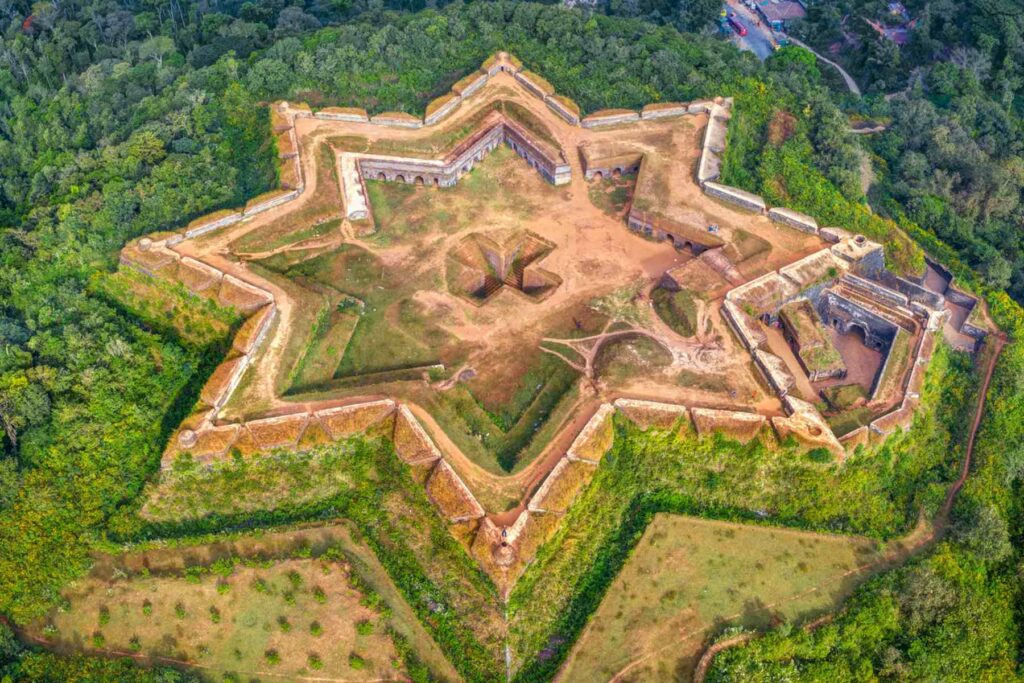
- Key attractions: Manjarabad Star Fort (historic hilltop fort with 360° views); pristine coffee estates and spice gardens; Ballal’s Seat viewpoint; nearby Kodachadri range (north of Sakleshpur); local temples.
- Best things to do: Trek up Manjarabad Fort via spice-scented forest; drive or jeep through the Chikmagalur–Sakleshpur ghat (Charmadi Ghat) – stops like Kallu Dodda Falls can be enjoyed if the road permits; wander through plantations; sample local Malnad cuisine. The quiet hills are great for couples who enjoy scenic picnics or solo travelers seeking solitude.
- Ideal time: July–September. Monsoon rains nourish the hills, and Sakleshpur’s landscapes become deep green. By June end the ghat is open; heavy rains peak mid-July through August. Unlike lower-coastal areas, Sakleshpur’s elevation keeps temperatures milder.
- Travel tips: Charmadi Ghat road can flood or close in very heavy rain; check local news. Wear rubber sandals for slippery ghat-steps. Many treks/waterfalls are on private or forest land – hire local guides or ask for permission. Keep valuables dry; even covered vehicles may face small landslides in extreme weather.
6.Yana
Yana is a village in Uttara Kannada known for its two towering black basalt monoliths (Bhairaveshwara & Mohini Shikhara) rising above jungle. Surrounded by tropical forest, Yana’s setting is mystical in the Top 10 Monsoon Destinations in Karnatak, with mist cloaking the treks and the small Vibhuti Falls nearby adding to the drama.
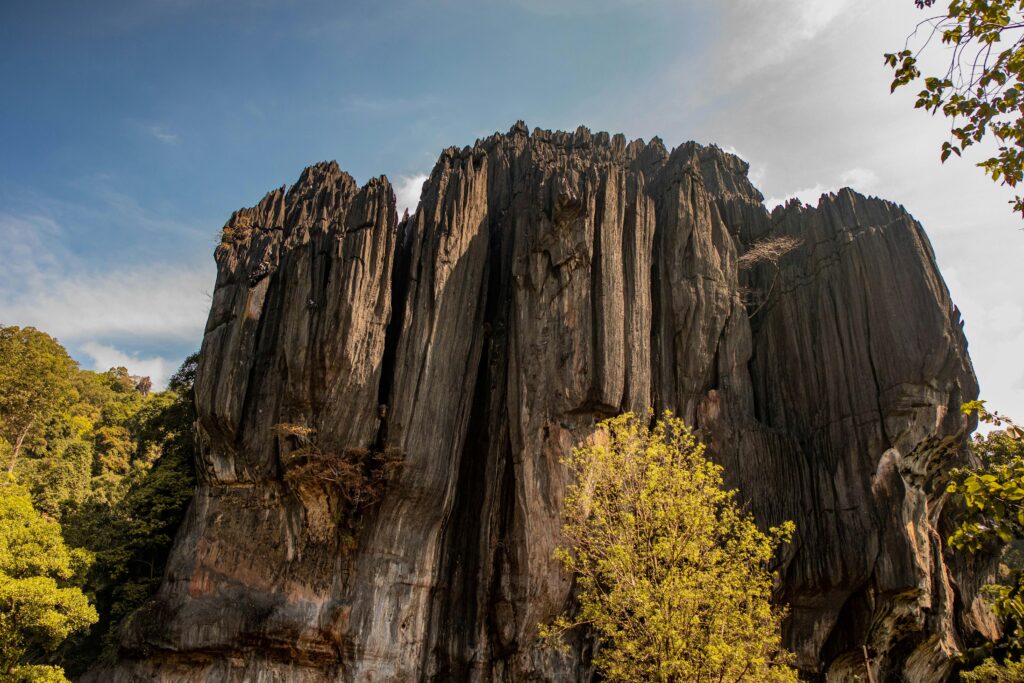
- Key attractions: Yana Rocks (unusual 300-ft volcanic rock pillars); Vibhuti Falls (a seasonal cascade beside the trail); dense hill forests and butterfly gardens in the vicinity.
- Best things to do: Trek the ~1.5 km forest path to the base of Yana rocks (it’s an easy hike, though muddy in monsoon); photograph the rock faces framed by green; visit the tiny Shri Bhairaveshwara cave temple at their base. A short walk beyond leads to Vibhuti Falls – a hidden waterfall perfect for a refreshing dip. Couples will enjoy the secluded ambience; solo nature buffs will relish the rare geology and wildlife (spotted deer, gibbons).
- Ideal time: July–September. The falls and jungle are most verdant in rainy months. Summer (Mar–May) is dry and dusty; monsoon brings luxuriant ferns on the rock faces. Even after rains subside (Oct), Yana remains green but check that the falls still flow (they typically dwindle by late monsoon).
- Travel tips: The trek to Yana is mostly flat but slippery; wear good hiking shoes. Leech socks or repellent are advisable in wet weather. Toilets and cafes are scarce, so carry snacks and water. There is a small entry fee to visit Yana Rocks (managed by locals). Leave early in the day – the forest can be foggy by evening.
7. Dandeli
In Uttara Kannada, Dandeli is a river-side forest destination on the Kali River. In Top 10 Monsoon Destinations in Karnataka the region’s Kali Tiger Reserve turns emerald and rivers swell. Though known for white-water rafting, the lush jungle and its wildlife thrive after rains, making it a year-round adventure spot.
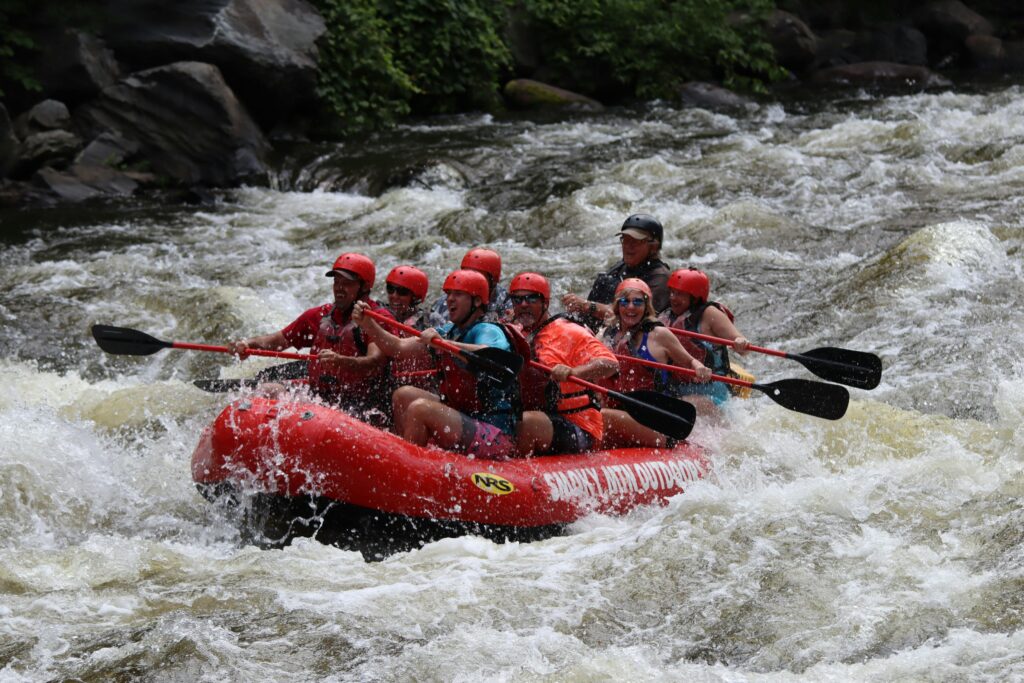
Key attractions: Kali River backwaters and rapids (for rafting/kayaking); Dandeli Wildlife Sanctuary (home to elephants, tigers, hornbills); Syntheri Rocks (giant limestone outcrop in forest).
Best things to do: White-water rafting (July–Sept gives wild rapids on Kali) – only on safer sections as advised; evening jungle safari or birdwatching (monsoon means active wildlife and breeding season); bamboo rafting on tranquil backwaters; spotting the famous singing Malabar Indian cuckoo; hiking in the sanctuary forest. For couples, riverbank camps and relaxing boat rides are romantic; solos can take long wildlife trails.
Ideal time: July–September offers lush forest and strong river flow. The post-monsoon (Oct–Feb) is also very pleasant for outdoor activities. Note: [Dandeli360] notes that July (with ~24 rainy days) can cancel water sports, so plan trips around lighter rain or early monsoon when rapids start building.
Travel tips: Book rafting with licensed operators and heed safety instructions. Wear a wetsuit/poncho for drizzle. Trails in the sanctuary can be muddy; gumboots help. Keep a rain cover for cameras (jungle spray). Check whether safari jeeps are allowed in monsoon (sometimes limited). The humidity is high – stay hydrated and use anti-chafe creams.
8. Kodachadri
Kodachadri is a 1,343 m peak in Shimoga’s Western Ghats (part of Mookambika Wildlife Sanctuary). It’s famed for misty treks through evergreen forest to an ancient temple at the top. Monsoon rains turn Kodachadri’s slopes into a flowing green carpet with hidden waterfalls (e.g. Hidlumane Falls) and rich birdlife.
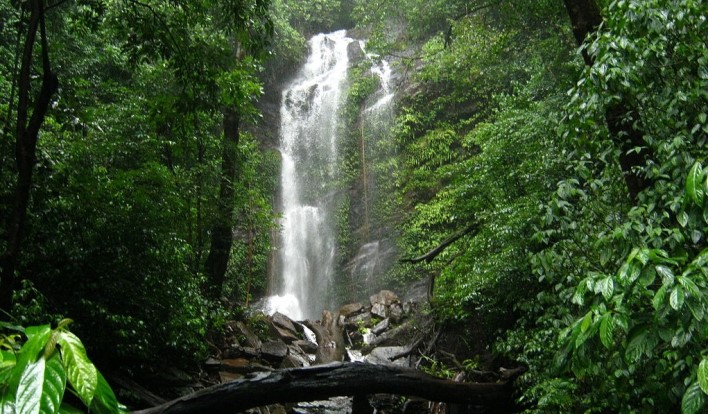
- Key attractions: Peak temple and Ganesha Guha (a cave with a Shiva idol) atop Kodachadri; Hidlumane Falls (a secret cascades on the trek route); panoramic sunset spots (clear days can even reveal the Arabian Sea). The entire hill is a Natural Heritage Site.
- Best things to do: Trek the 5–6 km forest trail from Kollur (dense spine-stick jungles with tall trees); mid-trek stops at the small Ganesh cave; reach the peak by dusk for sunset. The monsoon trail is atmospheric (green ferns, dripping foliage), making it a magical solo or couple’s adventure. Camping is possible with permission for an overnight rain‑forest experience.
- Ideal time: Late monsoon (August–early September) ensures moist, cool conditions and full streams. Most guides caution that post-monsoon (Oct–Feb) is technically best (clear weather), but heavy monsoon yields the richest jungle scenery. If trekking in rains, avoid thunderstorms and hire a local guide for the unmarked path.
- Travel tips: Carry rainwear and hiking poles (steps are muddy). The trail gets steep near the peak – take breaks. Check Kollur weather – trails may be closed on heavy-rain days. There is no mobile network deep on the hill; inform someone of your itinerary. Nighttime trekkers should be extremely cautious, as the path is dark.
9.Kudremukh
Kudremukh Peak (1,894 m) is a treeless “horse-face” mountain in Chikmagalur’s Western Ghats. It lies within Kudremukh National Park, a UNESCO biodiversity hotspot of rolling shola grasslands and evergreen forests. In monsoon the entire grassland turns emerald and waterfalls like Kadambi gush.
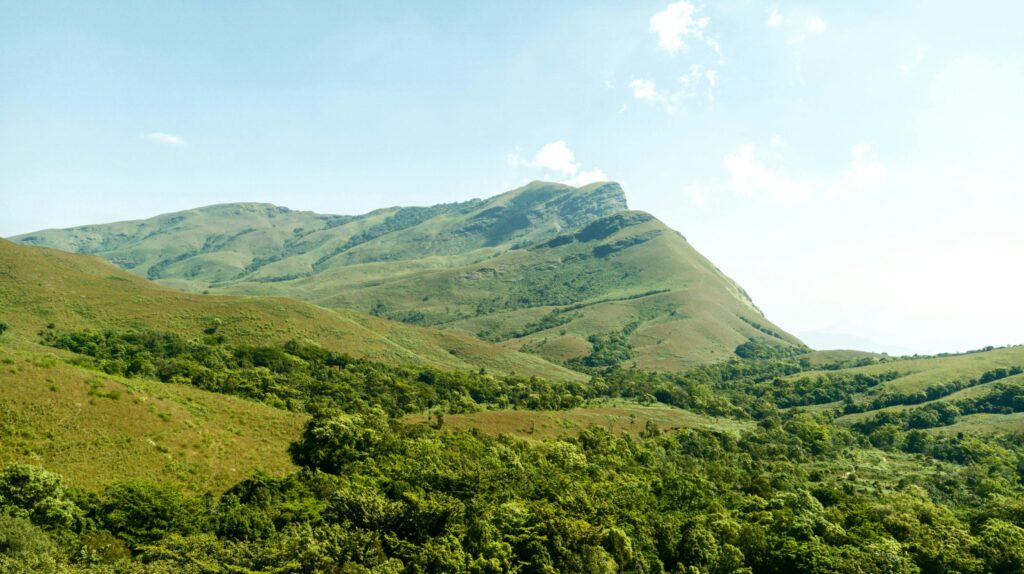
- Key attractions: Kudremukh Peak trek (moderate 18 km trail through open meadows); Kadambi and Gangamoola Falls at the park edges; diverse flora (stunted tropical trees) and fauna (lion-tailed macaques, sambar, eagles). The peak’s summit offers unparalleled sea-of-grass vistas.
- Best things to do: Join the overnight trek to Kudremukh summit for starry-night camping (obtain permits in advance); spot Malabar whistling thrush and hornbills. The grasslands are unique – ideal for photographers and couples who enjoy sunrise views together. Nature walks along the park roads can reveal bison and deer.
- Ideal time: June–September – monsoon fills all streams and the grasses are lush. (Note: the park’s own advisory says Oct–May is best for trekking, but the rains do make Kudremukh spectacular if trails are passable.) Aim for late monsoon when trails have dried slightly but greenery remains.
- Travel tips: Permits are mandatory and trekking is strictly guided by the forest department. The monsoon trail is extremely slippery – only attempt in fair weather and with rain jackets. Camping is prohibited (as per rules), so plan a day trek or arrange lodge stays nearby. Carry extra calories/packets (energy bars) as physical effort is high.
10. Kabini (Nagarhole)
Kabini (in Kodagu/Nagarhole) is a riverine forest sanctuary famed for its wildlife. Monsoon rejuvenates the dry deciduous woods and fills the Kabini reservoir, making the forest alive and verdant. The rich green landscape is ideal for wildlife photography – it’s the season of fawns, blooming plants and active birds.
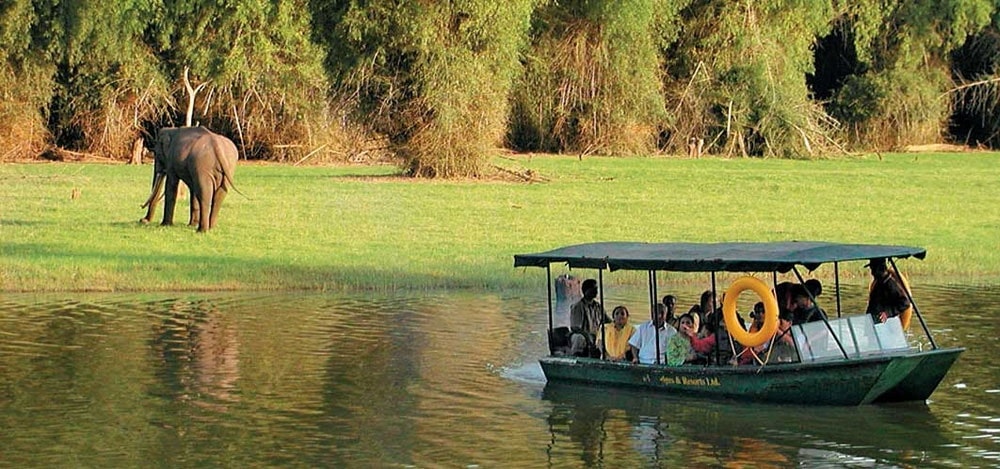
- Key attractions: Kabini Backwaters (spot gaurs, elephants at the lakeside); Kabini Wildlife Sanctuary tours (elephants, tigers, leopards, deer); boat safaris on the Kabini River; butterfly and bird diversity.
- Best things to do: Morning jungle safari in a gypsy (keen-eyed drivers can see herds of deer/calves, leopards on tree perches, elephants bathing); sunset boat ride on the reservoir (tigers may even swim). The monsoon forest provides a unique canvas – lone rays of light in dense canopy make for magical photography. A relaxing riverside lodge stay is perfect for couples.
- Ideal time: June–September (Kabini’s rainy season). The early monsoon (Jun–Jul) turns the forest emerald and raises the water level. According to wildlife guides, the “best time is June–February” for lush scenery. Monsoon nights cool down (about 20–25°C) and daytime is comfortable (around 25–34°C).
- Travel tips: Book safaris in advance as they run year-round. Carry binoculars and rain protection (it may drizzle). The narrow dirt roads can be muddy; wear mud-proof shoes. Drink bottled water and use mosquito repellent after dusk. Follow all wildlife-safari instructions (keep quiet, stay in vehicle). Avoid straying on your own; Kabini is best enjoyed via guided tours.
Conclusion – Monsoon Travel Advice for Karnataka
Monsoon in Karnataka unveils lush hill country and dramatic waterfalls, but it demands extra caution. Always check local weather and road conditions daily, and avoid travel during heavy downpours. Pack a waterproof jacket, quick-dry clothes, strong insect repellent and sealed bags for electronics. Footwear with good grip is essential – even flat trails become very slippery. Stay only on marked paths or guided tours (forest permits are often required). Plan activity times flexibly: do early treks/wildlife safaris before afternoon rains. Avoid camping in flash‑flood‑prone valleys and never swim in swollen rivers. Despite these challenges, Top 10 Monsoon Destinations in Karnataka reward travelers with cool temperatures, fewer crowds, and riotously green scenery – perfect for romantic escapes or immersive solo adventures. Happy and safe travels!

